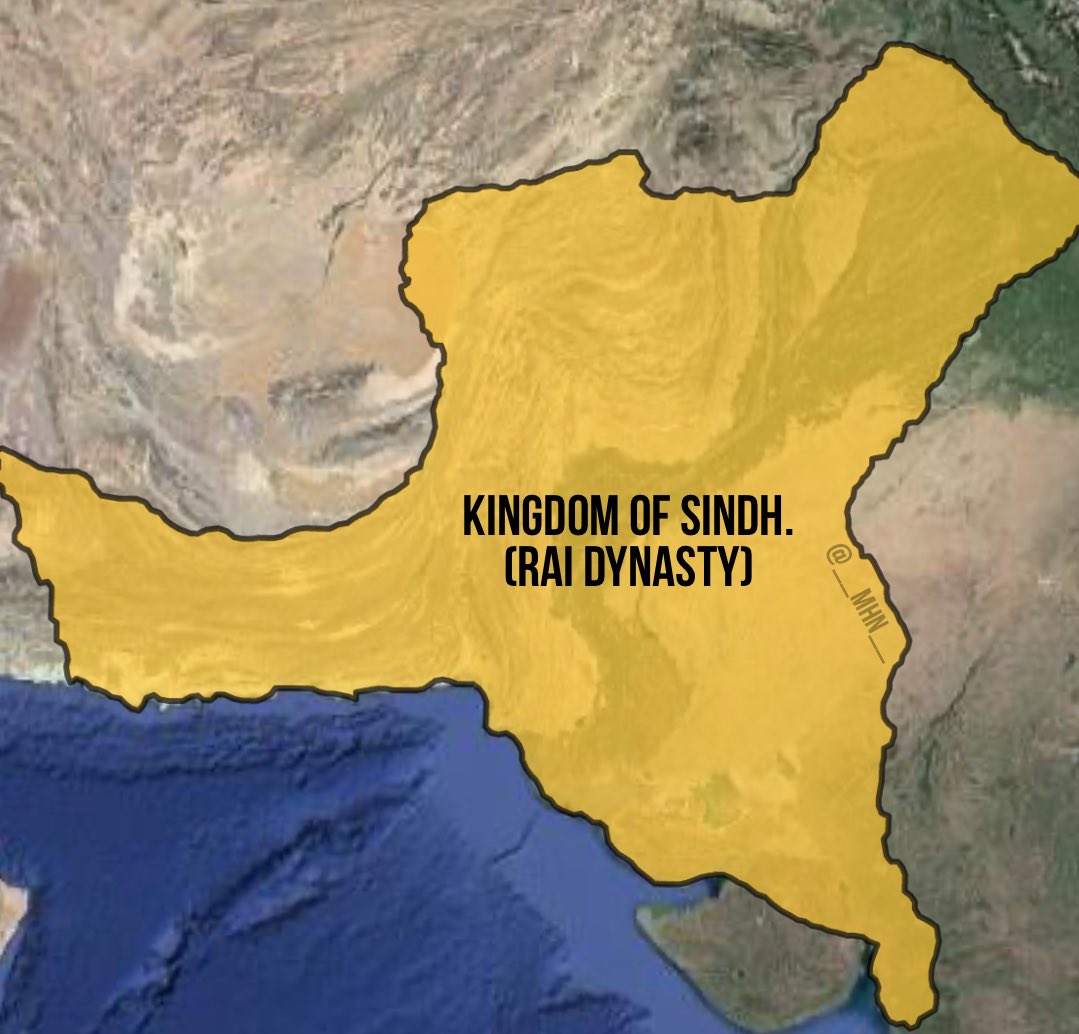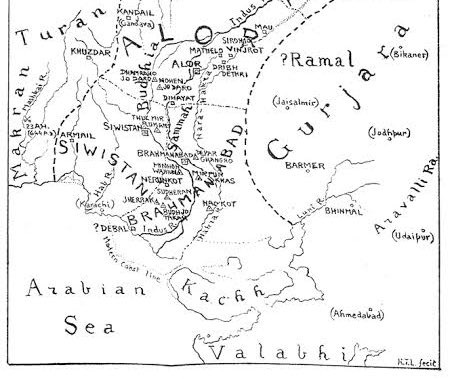Lesser Known Fact:
Contrary to many claiming Pakistan never had a large enough Kingdom/Empire, there existed an indigenous Kingdom which covered most of Pakistan and parts of India, Afghanistan and Iran b/w 489 & 632.
Thread on the Rai Dynasty and the Kingdom of Sindh:
Contrary to many claiming Pakistan never had a large enough Kingdom/Empire, there existed an indigenous Kingdom which covered most of Pakistan and parts of India, Afghanistan and Iran b/w 489 & 632.
Thread on the Rai Dynasty and the Kingdom of Sindh:
Establishment:
It was founded in 489 by King Rai Diwaji who was a Buddhist. Therefore Buddhism became the royal religion and experienced a boom in the predominantly Buddhist Indus Valley. [1]
It was founded in 489 by King Rai Diwaji who was a Buddhist. Therefore Buddhism became the royal religion and experienced a boom in the predominantly Buddhist Indus Valley. [1]
The empire itself was created parallel to the invasion of White Huns in northern Indus which weakened Sassanid control and as a result the Rais pushed them out of the Indus region. [2]
Rulers:
The Kingdom had 5 rulers of the Rai dynasty. The extent of their rule isn’t fully deciphered but the general overview of the start of their rule is:
Rai Diwaji - 489 AD.
Rai Siharas: 535 AD.
Rai Sahasi: 565 AD.
Rai Siharas II: 595 AD.
Rai Sahahsi II: 627 AD. [3]
The Kingdom had 5 rulers of the Rai dynasty. The extent of their rule isn’t fully deciphered but the general overview of the start of their rule is:
Rai Diwaji - 489 AD.
Rai Siharas: 535 AD.
Rai Sahasi: 565 AD.
Rai Siharas II: 595 AD.
Rai Sahahsi II: 627 AD. [3]
Boundaries:
The boundaries of the kingdom reached the foothills of Kashmir in the north. Kandhar and Suleman mountains in the north west. Bounded by Kerman in the west. It also controlled Surat Port in the south east and extended till the boundaries of Kanauj in the east. [4]
The boundaries of the kingdom reached the foothills of Kashmir in the north. Kandhar and Suleman mountains in the north west. Bounded by Kerman in the west. It also controlled Surat Port in the south east and extended till the boundaries of Kanauj in the east. [4]
In colonial terms it extended from Jodhpur and Jaisalmar in the east, Sistan and Baluchistan in the west and Punjab in the north.
In contemporary terms, it included Punjab, Sindh and Baluchistan of Pakistan, Kandahar (Afg), Sistan (Iran) and parts of Rajasthan (Ind). [5]
In contemporary terms, it included Punjab, Sindh and Baluchistan of Pakistan, Kandahar (Afg), Sistan (Iran) and parts of Rajasthan (Ind). [5]
Provinces:
Rai Sahiras II divided his Kingdom into 5 provinces, of which four were:
1) Brahmanabad: To Look after Nerun (Hyderabad), Debul, Luhanah and the river.
2) Siwistan: With Sehwan as its headquarters to look after Ludhia and the Rojhan hills.
Rai Sahiras II divided his Kingdom into 5 provinces, of which four were:
1) Brahmanabad: To Look after Nerun (Hyderabad), Debul, Luhanah and the river.
2) Siwistan: With Sehwan as its headquarters to look after Ludhia and the Rojhan hills.
3) Iskandeh: To look after babiah, Chachpur (Rawalpindi District)
4) Multan: To look after Sikah, Karad and the boundary of Kashmir. [6]
4) Multan: To look after Sikah, Karad and the boundary of Kashmir. [6]
Capital:
Their capital was Alor in Sindh which has been described in the Chachnamah as a city adorned with villas, gardens, royal Buildings, fountains, streams, meadows and trees located on the banks of the Mehran (Indus). [7]
Their capital was Alor in Sindh which has been described in the Chachnamah as a city adorned with villas, gardens, royal Buildings, fountains, streams, meadows and trees located on the banks of the Mehran (Indus). [7]
Zenith:
At its Zenith the Kingdom stretched from Kandahar till Surat and Kashmir till Debul. Tolerance was the ruler and though the Kings were Buddhists there was tolerance for Brahminism. Peace existed and their forts overflowing with granaries and wealth. [8]
At its Zenith the Kingdom stretched from Kandahar till Surat and Kashmir till Debul. Tolerance was the ruler and though the Kings were Buddhists there was tolerance for Brahminism. Peace existed and their forts overflowing with granaries and wealth. [8]
De - establishment:
The kingdom and with it the the dynasty was de established after the death of Rai Sahasi II when his Brahmin Wazier usurped the throne and killed the claimants. [9]
His son, Dahir, was defeated by the indomitable tide of Islam decades later.
The kingdom and with it the the dynasty was de established after the death of Rai Sahasi II when his Brahmin Wazier usurped the throne and killed the claimants. [9]
His son, Dahir, was defeated by the indomitable tide of Islam decades later.
References:
[1] Chachnamah Retold - G. Khushalani.
[2] Grassroots V. 23-24 University of Sindh.
[3] Proceedings of 9th International Congress of Orientalists.
[4] Gazeteet of Province of Sindh.
[5] Chachnamah Retold - G. Khushalani.
[6] Ibid.
Yes
[1] Chachnamah Retold - G. Khushalani.
[2] Grassroots V. 23-24 University of Sindh.
[3] Proceedings of 9th International Congress of Orientalists.
[4] Gazeteet of Province of Sindh.
[5] Chachnamah Retold - G. Khushalani.
[6] Ibid.
Yes
[7] The Chachnamah - Ancient History of Sindh.
[8] Sindhi roots and rituals - D. N. Harjani.
[9] Ibid.
[8] Sindhi roots and rituals - D. N. Harjani.
[9] Ibid.
Note:
The map is my own creation since, surprisingly, there exists no map of the Kingdom of the Rai Dynasty.
It is based on multiple sources.
The map is my own creation since, surprisingly, there exists no map of the Kingdom of the Rai Dynasty.
It is based on multiple sources.
Another thing to note, this isn’t the only indigenous kingdom to have existed. There’s a plethora of indigenous Kingdoms which existed in Pakistan but this one is of importance because it covered roughly much of Pakistan’s land mass.

 Read on Twitter
Read on Twitter
![Establishment:It was founded in 489 by King Rai Diwaji who was a Buddhist. Therefore Buddhism became the royal religion and experienced a boom in the predominantly Buddhist Indus Valley. [1] Establishment:It was founded in 489 by King Rai Diwaji who was a Buddhist. Therefore Buddhism became the royal religion and experienced a boom in the predominantly Buddhist Indus Valley. [1]](https://pbs.twimg.com/media/EW8z2r_XQAECBh8.jpg)
![The empire itself was created parallel to the invasion of White Huns in northern Indus which weakened Sassanid control and as a result the Rais pushed them out of the Indus region. [2] The empire itself was created parallel to the invasion of White Huns in northern Indus which weakened Sassanid control and as a result the Rais pushed them out of the Indus region. [2]](https://pbs.twimg.com/media/EW8z3ntWAAE4EQG.jpg)
![The empire itself was created parallel to the invasion of White Huns in northern Indus which weakened Sassanid control and as a result the Rais pushed them out of the Indus region. [2] The empire itself was created parallel to the invasion of White Huns in northern Indus which weakened Sassanid control and as a result the Rais pushed them out of the Indus region. [2]](https://pbs.twimg.com/media/EW8z3nzXQAQFHsO.jpg)
![Rulers: The Kingdom had 5 rulers of the Rai dynasty. The extent of their rule isn’t fully deciphered but the general overview of the start of their rule is: Rai Diwaji - 489 AD. Rai Siharas: 535 AD. Rai Sahasi: 565 AD.Rai Siharas II: 595 AD.Rai Sahahsi II: 627 AD. [3] Rulers: The Kingdom had 5 rulers of the Rai dynasty. The extent of their rule isn’t fully deciphered but the general overview of the start of their rule is: Rai Diwaji - 489 AD. Rai Siharas: 535 AD. Rai Sahasi: 565 AD.Rai Siharas II: 595 AD.Rai Sahahsi II: 627 AD. [3]](https://pbs.twimg.com/media/EW8z4jcWkAUhhqJ.jpg)
![Boundaries: The boundaries of the kingdom reached the foothills of Kashmir in the north. Kandhar and Suleman mountains in the north west. Bounded by Kerman in the west. It also controlled Surat Port in the south east and extended till the boundaries of Kanauj in the east. [4] Boundaries: The boundaries of the kingdom reached the foothills of Kashmir in the north. Kandhar and Suleman mountains in the north west. Bounded by Kerman in the west. It also controlled Surat Port in the south east and extended till the boundaries of Kanauj in the east. [4]](https://pbs.twimg.com/media/EW8z5HRWAAAy0iB.jpg)
![In colonial terms it extended from Jodhpur and Jaisalmar in the east, Sistan and Baluchistan in the west and Punjab in the north. In contemporary terms, it included Punjab, Sindh and Baluchistan of Pakistan, Kandahar (Afg), Sistan (Iran) and parts of Rajasthan (Ind). [5] In colonial terms it extended from Jodhpur and Jaisalmar in the east, Sistan and Baluchistan in the west and Punjab in the north. In contemporary terms, it included Punjab, Sindh and Baluchistan of Pakistan, Kandahar (Afg), Sistan (Iran) and parts of Rajasthan (Ind). [5]](https://pbs.twimg.com/media/EW8z6AxXkAAFpLb.jpg)

![3) Iskandeh: To look after babiah, Chachpur (Rawalpindi District)4) Multan: To look after Sikah, Karad and the boundary of Kashmir. [6] 3) Iskandeh: To look after babiah, Chachpur (Rawalpindi District)4) Multan: To look after Sikah, Karad and the boundary of Kashmir. [6]](https://pbs.twimg.com/media/EW8z7vdWAAAI8GN.jpg)
![Capital: Their capital was Alor in Sindh which has been described in the Chachnamah as a city adorned with villas, gardens, royal Buildings, fountains, streams, meadows and trees located on the banks of the Mehran (Indus). [7] Capital: Their capital was Alor in Sindh which has been described in the Chachnamah as a city adorned with villas, gardens, royal Buildings, fountains, streams, meadows and trees located on the banks of the Mehran (Indus). [7]](https://pbs.twimg.com/media/EW8z8T1XsAEvVGE.jpg)
![Zenith: At its Zenith the Kingdom stretched from Kandahar till Surat and Kashmir till Debul. Tolerance was the ruler and though the Kings were Buddhists there was tolerance for Brahminism. Peace existed and their forts overflowing with granaries and wealth. [8] Zenith: At its Zenith the Kingdom stretched from Kandahar till Surat and Kashmir till Debul. Tolerance was the ruler and though the Kings were Buddhists there was tolerance for Brahminism. Peace existed and their forts overflowing with granaries and wealth. [8]](https://pbs.twimg.com/media/EW8z9JBX0AA6mIa.jpg)
![De - establishment: The kingdom and with it the the dynasty was de established after the death of Rai Sahasi II when his Brahmin Wazier usurped the throne and killed the claimants. [9]His son, Dahir, was defeated by the indomitable tide of Islam decades later. De - establishment: The kingdom and with it the the dynasty was de established after the death of Rai Sahasi II when his Brahmin Wazier usurped the throne and killed the claimants. [9]His son, Dahir, was defeated by the indomitable tide of Islam decades later.](https://pbs.twimg.com/media/EW8z9toXgAAEhr1.jpg)


